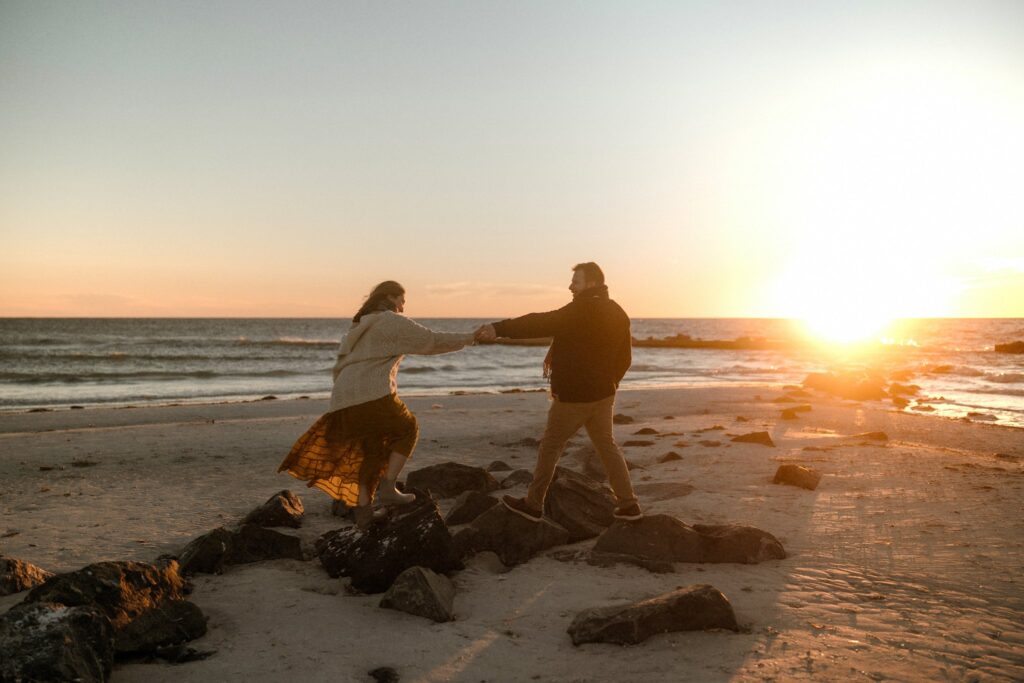Unfiltered Skies
Feb 19, 2024

Sunset Beach Photography Without Clouds
Imagine standing on the edge of a picturesque shoreline, the sun slowly dipping below the horizon, the sky is painted with a vibrant palette of colors. As a photographer, capturing this stunning display cohesively with our clients on a clear evening can present a unique challenge.
When photographing a sunset with a cloudless sky, the first step is understanding how such conditions affect the end result. The absence of clouds shifts the colors and lighting of the sunset, and understanding these changes can aid in enhancing your compositions and crafting captivating images.
Position
To capture the vibrant hues of a sunset in clear skies, it’s critical to consider the sun’s position in relation to your shooting location and subject. The sunset’s colors and intensity can be greatly affected by the angle at which the sun sets, so experimenting with different vantage points to find the optimal composition for light is key.
Shooting directly towards the sun can cause the sky to appear white. Meanwhile, shooting at an angle away from the sun, or towards the side, allows the colors to truly pop, with the added benefit of naturally lighting your subject.



Clothing
Try allowing light to filter through clothing to add visual interest. A cloudless sky can sometimes appear one-dimensional, and having your subject wear clothing that allows for movement can add another layer of dimension to the scene.
Experiment with different fabrics, such as lace, chiffon, or denim, and see how they interact with the light. Don’t be afraid to mix and match – sometimes the most unexpected combinations can create the most visually compelling pictures. Remember, the key is to be intentional in your choices and consider how they will enhance the overall aesthetic of your image.

Get Low
Try getting low with your camera. This positions your subject against the backdrop of the sky, which essentially serves as a blank canvas which can produce striking images.
The key to capturing truly remarkable photos is all about perspective. Often times, we default to taking photos at eye level, but what if we challenged ourselves to change our viewpoint? By getting low to the ground with our camera, we open up a whole new world of possibility. Suddenly, the sky becomes our blank canvas and our subject takes center stage against a stunning backdrop. Not only does this add depth and dimension to our photos, but it also creates a sense of uniqueness that will surely leave a lasting impact on anyone who views them.



Filters
I’ve mentioned in the past, but using a diffusion filter can be extremely beneficial during harsh light. A diffusion filter spreads the highlights, giving them a softer appearance, while also spreading color across the frame. This not only helps to reduce the harshness of the light, but it also adds a dreamy and ethereal quality to the image.
The image on the left is without a diffusion filter wile the one on the right I have used one. Notice the colors of the sky and how it’s retained much better.


My next adventure, and I’ll take you along with me will be using a polarizing filter. The purpose of this is to keep the natural saturation of the colors in the sky and to be able to slow down my shutter speed for interesting images using a bit of motion blur.

Timing
When it comes to photography, timing is everything. It’s not just about capturing the perfect shot, but also about creating a mood and setting a tone. My favorite time to shoot is during what is known as the “golden hour”, which is the hour before sunset. Except I push this rule by 15 mintues. I like to start my beach sessions no more than 45 minutes before the sun actually sets. During this time, the light is soft and warm, casting a beautiful glow on everything it touches. It’s the perfect setting for beach photography, as the water and sand take on a dreamy quality. Additionally, it allows you to shoot a bit into the “blue hour” when the colors are at their best!
But what if you find yourself faced with harsh lighting conditions? Don’t panic. Instead, get creative and seek out shaded areas or shoot from a different angle to capture stunning and unique shots. Remember, great photography is all about adaptation and finding beauty in unexpected places.
Let your clients know what you’re doing and why. I promise they won’t mind, in fact… you’ll find that they appreciate your vast knowledge of the situation and willingness to get the best possible outcome for them.

Be the first to comment